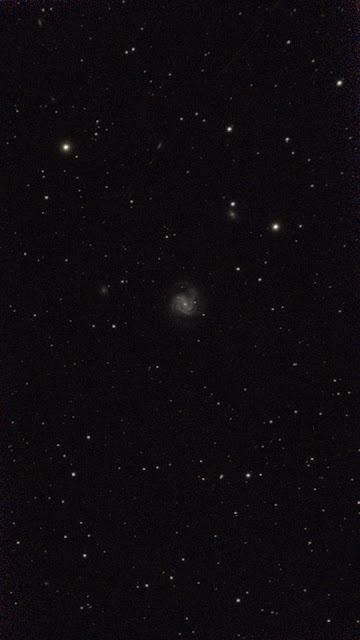Plus Extras
Three relatively dark moonless nights happened in late February and early March. Annoying neighbor lights were mostly off during this time, so it was a good opportunity to fire up Seestar and gather more galaxies for my Messier collection. I ended up adding eight Messier galaxies in Virgo to the other 94 Messier objects I've previously captured. Virgo contains a rich distribution of galaxies. Images below show six Messier galaxies together with companions sharing the same field of view.
First is giant elliptical galaxy M87, the brightest galaxy in Virgo. Unlike prettier spiral galaxies, M87 looks like a fuzzy ball. Elliptical galaxies have less overall angular momentum (rotation) than spiral galaxies and thus don't flatten into a disk shape. A massive black hole exists in M87's center. An incredible picture of this black hole can be viewed at this link: https://science.nasa.gov/resource/first-image-of-a-black-hole/ .
In all the following images I'm disappointed that background sky isn't very black. Light pollution is probably the cause. I can't darken the background without also losing faint galaxy details. The following M87 image is a 25-minute exposure.
The next picture identifies three other galaxies near M87.
Two more elliptical galaxies, M59 and M60, are shown in the next picture along with six other galaxies in the same frame! See them all labeled in the second image below.
Very nice face-on spiral galaxy M61 and three companions appear next. These galaxies are labeled in the lower image.
Tilted spiral galaxy M90 with two dim companions is next. Once again, labels follow.
The previous three galaxy portraits are 30-minute exposures. The next image is a 60-minute exposure using Seestar's mosaic mode to capture 13 galaxies in one frame! This particular group is named Markarian's Chain after the astronomer who discovered their common movement. Labels identify the galaxies. Unfortunately, I should have centered this field of view more carefully. One remaining member of the chain is missing off the upper left edge. Perhaps I'll try again soon.
Finally, I include one extra image of edge-on galaxies in Canes Ventatici. The largest galaxy is NGC4631 with small companion NGC4627 nearby. The oddly shaped galaxy near bottom is NGC4656 which appears to have a hook-like feature on its left end. The hook is actually another galaxy, NGC4657. See labels below.
At this point I've imaged 102 of the 110 Messier objects. The remaining eight are located in Ophiuchus and Sagittarius. It may be a few months before these constellations rise high enough for convenient imaging.






















